|
|
|
Sort Order |
|
|
|
Items / Page
|
|
|
|
|
|
|
| Srl | Item |
| 1 |
ID:
140956
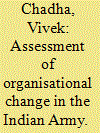

|
|
|
|
|
| Summary/Abstract |
The article analyses military change in the context of the Indian Army, with specific focus on organisational innovation and change. In doing so, it analyses two case studies: restructuring of the army after the Sino-Indian War of 1962; and mechanisation based on the 1975 expert committee recommendations. On the basis of these case studies, the article assesses the drivers and desirables for organisational change in the Indian Army, with the further aim of deriving policy recommendations which are especially apt in light of the ongoing transformation of the army. It identifies operational environment and technology as the principle drivers for change, with doctrine and strategic culture having a limited impact. It further concludes that successful change requires long-term strategic assessment, supportive political leadership, visionary and committed military leadership, strong institutional structures and follow-up action.
|
|
|
|
|
|
|
|
|
|
|
|
|
|
|
|
| 2 |
ID:
146990
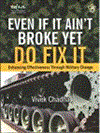

|
|
|
|
|
| Publication |
New Delhi, Pentagon Press (IDSA), 2016.
|
| Description |
x, 192p.: tables, chartshbk
|
| Standard Number |
9788182749191
|
|
|
|
|
|
|
|
|
|
|
|
Copies: C:2/I:0,R:0,Q:0
Circulation
| Accession# | Call# | Current Location | Status | Policy | Location |
| 058766 | 355.033054/CHA 058766 | Main | On Shelf | General | |
| 058767 | 355.033054/CHA 058767 | Main | On Shelf | General | |
|
|
|
|
| 3 |
ID:
186136
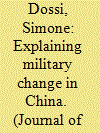

|
|
|
|
|
| Summary/Abstract |
Since the mid-1990s, the operational doctrine of the People’s Liberation Army (PLA) has increasingly focused on jointness. For two decades, however, the PLA’s organizational structure did not adapt accordingly. A major reform was eventually passed in 2015, with the establishment of a new joint operational command system. This 20-year institutional lag is explained by the changing pattern of civilian intervention in military affairs. Even more than doctrinal change, organizational change is likely to be met with resistance from within the military. A facilitating role is then played by civilians who provide external support to pro-reform senior military officers. Yet, such external support depends on the state of civil–military relations, which determines the room for civilian intervention in the military sphere.
|
|
|
|
|
|
|
|
|
|
|
|
|
|
|
|
| 4 |
ID:
176575
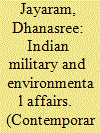

|
|
|
|
|
| Summary/Abstract |
In India, issues related to environmental governance have not been aligned to the military’s objectives except in a few cases. Since environmental change has not been recognised as a critical 'security' issue yet in India, there is a reluctance on the part of the security establishment, including the military, to deal with it on an urgent basis. The question of why the armed forces should be trained to undertake environmental activities when their primary duty is to defend the country against external aggression assumes significance as it is largely believed that if they are trained for the former, their primary functions could suffer and territorial integrity of the nation could be threatened. Other impediments to institutionalisation include the complex relations between the civil and military establishments; constitutional and legal status of the Indian armed forces that is not uniformly enshrined or recognised; and their societal status that still comes under constant scrutiny, leading to a wedge between the military and civilian domains. In this context, the article attempts to identify the doctrinal and policy dimensions of the Indian military’s role in environmental affairs as well as the factors that influence formal institutionalisation.
|
|
|
|
|
|
|
|
|
|
|
|
|
|
|
|
| 5 |
ID:
145861
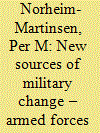

|
|
|
|
|
| Summary/Abstract |
The literature on how European states have adapted to the post-cold war security environment ffocuses invariably on different understandings of military transformation, a process which is seen as inherently different from other forms of organizational change. However, as this paper argues, new management practices, going back to the introduction of so-called New Public Management (NPM) reforms throughout Europe in the 1980s, have eventually penetrated also the last bastion of the old state – the defense sector. Taking a critical approach to the idea of military transformation and existing theories of military change, the paper demonstrates how other international developments have pushed towards what may be seen as a “normalization” of Europe’s defense sectors. This has important implications for how we approach and understand change in contemporary defense organizations.
|
|
|
|
|
|
|
|
|
|
|
|
|
|
|
|
| 6 |
ID:
151395
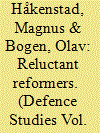

|
|
|
|
|
| Summary/Abstract |
The Norwegian Armed Forces has seen extensive reforms since the early 1990s. It has been changed from a large, conscription-based, reservist-dominated territorial Defense force to a smaller, more proficient, and flexible force. However, this process has been far from linear, and to this day the Norwegian Armed Forces retains significant elements of its organizational and cultural cold war heritage. We argue that national security concerns, domestic politics and financial constraints have played the main role in shaping the reform of the Armed Forces. This argument gives an alternative to explanations offered by previous research, which has tended to emphasize the role played by international influences, such as the NATO operations in the Balkans and Afghanistan, as well as NATO and US reform initiatives. While external factors undoubtedly have shaped the direction and tempo of the reforms, our findings point to long-standing structural and financial imbalances as the key explanation of the current structure of the Norwegian Armed Forces.
|
|
|
|
|
|
|
|
|
|
|
|
|
|
|
|
|
|
|
|
|